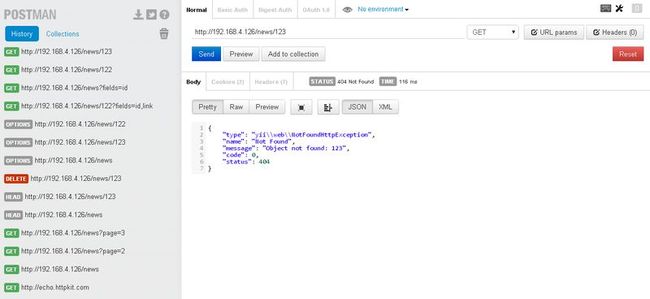RESTful API Develop
yii2 RESTful API Develop
参考文档:http://www.yiiframework.com/doc-2.0/guide-rest.html
以 DB 中的 news 表为例创建该资源的 RESTful API,最终的测试通过工具 POSTMAN 测试如下图;
通过 yii2 ,非常方便的创建 RESTful API
步骤:
- 准备工作,配置友好的 URLManager
- 创建News Model (via gii)
- 创建News Controller
- 测试
- 高级
1. 配置 friendly Url
参看另一篇文章 http://www.cnblogs.com/ganiks/p/yii2-config.html
'urlManager' => [ 'enablePrettyUrl' => true, 'showScriptName' => false, 'enableStrictParsing' => true, 'rules' => [ '<controller:\w+>/<id:\d+>' => '<controller>/view', '<controller:\w+>/<action:\w+>/<id:\d+>' => '<controller>/<action>', '<controller:\w+>/<action:\w+>' => '<controller>/<action>', ['class' => 'yii\rest\UrlRule', 'controller' => ['user', 'news']], ], ]原创文章,转载请注明 http://www.cnblogs.com/ganiks/
.htaccess 不要遗漏
2. 创建 News Model
3. 创建 News Controller
<?php namespace app\controllers; use yii\rest\ActiveController; class NewsController extends ActiveController { public $modelClass = 'app\models\News'; }4. 用Chrome工具 POSTMAN 测试
GET /news: list all news page by page;
HEAD /news: show the overview information of new listing; POST /news: create a new new; GET /news/123: return the details of the new 123; HEAD /news/123: show the overview information of new 123; PATCH /news/123 and PUT /news/123: update the new 123; DELETE /news/123: delete the new 123; OPTIONS /news: show the supported verbs regarding endpoint /news; OPTIONS /news/123: show the supported verbs regarding endpoint /news/123.5. Restful Api 验证和授权
首先参看我的另一篇译文 http://www.cnblogs.com/ganiks/p/Yii2-RESTful-Authentication-and-Authorization.html
官方文档中介绍了3种发送 access-token 的方法, 方便测试的有 http basic Auth 以及 Query parameter 两种
这里简单介绍下配置的流程:
-
config/web.php 设置
enableSession'user' => [ 'identityClass' => 'app\models\User', 'enableAutoLogin' => true, 'enableSession' => false, ] -
controllers/news.php
use yii\filters\auth\HttpBasicAuth; use yii\helpers\ArrayHelper; use yii\filters\auth\CompositeAuth; use yii\filters\auth\HttpBearerAuth; use yii\filters\auth\QueryParamAuth; public function behaviors() { return ArrayHelper::merge(parent::behaviors(), [ 'authenticator' => [ #这个地方使用`ComopositeAuth` 混合认证 'class' => CompositeAuth::className(), #`authMethods` 中的每一个元素都应该是 一种 认证方式的类或者一个 配置数组 'authMethods' => [ HttpBasicAuth::className(), HttpBearerAuth::className(), QueryParamAuth::className(), ] ] ]); } -
models/User.php
private static $users = [ '100' => [ 'id' => '100', 'username' => 'admin', 'password' => 'admin', 'authKey' => 'test100key', 'accessToken' => '100-token', ], '101' => [ 'id' => '101', 'username' => 'demo', 'password' => 'demo', 'authKey' => 'test101key', 'accessToken' => '101-token', ], ]; public static function findIdentityByAccessToken($token, $type = null) { foreach (self::$users as $user) { if ($user['accessToken'] === $token) { return new static($user); } } return null; }
两种方式测试一下:
- 访问 http://192.168.4.126/news/122 ,在弹出的登录对话框中输入用户名
100-token 或者 101-token, 密码任意,登录 - 直接访问 http://192.168.4.126/news/122?access-token=101-token
